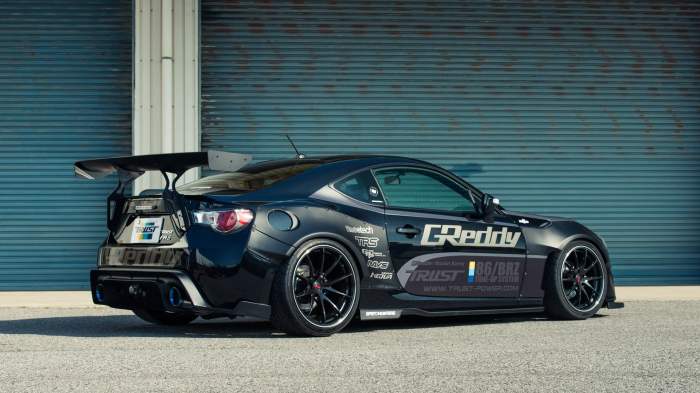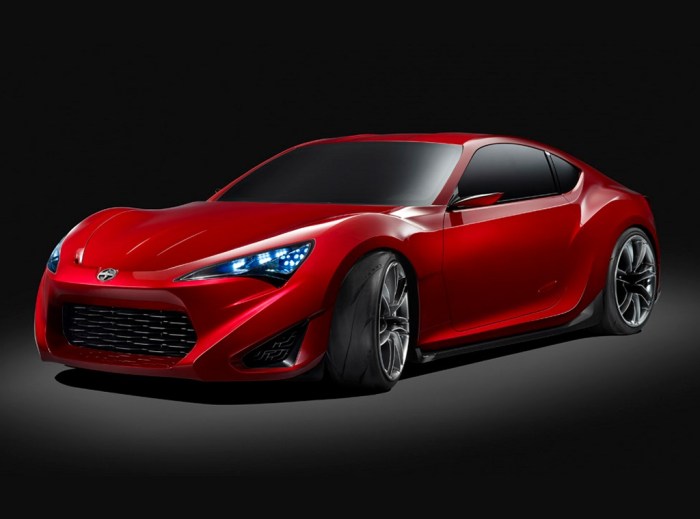Toyota Scion sports cars represent a unique chapter in automotive history. Launched as a sub-brand aimed at a younger, more style-conscious demographic, Scion offered a range of distinctive vehicles, from the boxy xB to the sporty tC and the highly-regarded FR-S.
This exploration delves into the brand’s rise, its surprising fall, and the lasting impact its models have had on car culture and the automotive landscape. We’ll examine the design philosophies, performance characteristics, and the passionate community that continues to embrace these vehicles.
This deep dive will cover Scion’s history, its relationship with Toyota, popular models like the xA, xB, tC, FR-S (and its twin, the Subaru BRZ), and the iQ. We’ll analyze their performance, handling, and the modifications often applied by enthusiasts.
Finally, we’ll look at the legacy of Scion and why certain models remain highly sought after even after the brand’s discontinuation.
Visual Representation of Popular Models

Scion, while sadly no longer with us, left behind a legacy of stylish and affordable sports cars. Their designs, while often understated, possessed a distinct character that resonated with a younger generation of drivers. Let’s take a closer look at the visual aspects of three popular models, focusing on their unique design elements and overall aesthetic.
Scion tC, Toyota scion sports car
The Scion tC, a sporty coupe, presented a sleek and aggressive profile. Its low-slung silhouette, characterized by a long hood and short rear deck, conveyed a sense of forward motion even when stationary. The sharp lines and angular features, particularly around the headlights and taillights, contrasted with smoother curves along the sides, creating a dynamic and visually interesting balance.
The interior was equally noteworthy, often featuring a driver-focused cockpit with supportive bucket seats and a clean, minimalist dashboard layout. A key design element was the large rear hatch, providing ample cargo space for its size, a practical feature not always found in sporty coupes.
The overall aesthetic was one of youthful energy and sophisticated simplicity.
Scion FR-S (Toyota 86/Subaru BRZ)
The FR-S, a collaboration with Subaru, adopted a more classic sports car aesthetic. Its silhouette, reminiscent of iconic rear-wheel-drive coupes, featured a long hood, short rear overhang, and a low center of gravity. Key design elements included the aggressive front fascia, featuring large air intakes for cooling, and the sculpted side panels that emphasized the car’s athletic stance.
The interior, while spartan, was functional and driver-oriented, emphasizing performance over luxury. Unique features included its near-perfect 50/50 weight distribution, which significantly contributed to its handling capabilities, reflected subtly in its balanced and poised visual presence. The overall impression was one of pure, unadulterated driving performance expressed through clean, efficient lines.
Scion xB
The Scion xB, a boxy compact hatchback, stood out for its unconventional and undeniably unique design. Its boxy silhouette, far from being unattractive, was actually quite striking. Sharp angles and straight lines dominated its exterior, creating a bold and almost futuristic appearance.
The large windows provided excellent visibility, while the high roofline offered surprising interior space. The interior design mirrored the exterior’s practicality, with a simple and functional layout. Unique features included its surprisingly spacious interior and versatile cargo area.
The xB’s aesthetic was a bold statement, defying conventional automotive design norms and embracing a quirky, yet undeniably appealing, character.
Concluding Remarks: Toyota Scion Sports Car

The Scion brand, while short-lived, left an undeniable mark. Its focus on unique styling, engaging driving dynamics (particularly in the FR-S), and a vibrant community fostered a level of enthusiasm rarely seen. While the brand itself is gone, the legacy of its sporty models and the passionate following they cultivated continue to thrive.
The Scion story serves as a compelling case study in targeted marketing, the importance of community building, and the enduring appeal of well-engineered, fun-to-drive cars. Ultimately, the Scion experience underscores the fact that even a relatively brief chapter in automotive history can leave a lasting impact.
Answers to Common Questions
What happened to the Scion brand?
Toyota discontinued the Scion brand in 2016, rebranding its models under the Toyota name. The decision was made as part of a corporate restructuring strategy.
Are Scion parts still available?
Many parts are still available through online retailers and some dealerships, though availability may vary depending on the model and part.
How reliable were Scion cars?
Reliability varied by model, but generally, Scion cars were considered reasonably reliable, benefiting from Toyota’s engineering expertise.
What makes the FR-S/GT86 so popular?
Its rear-wheel-drive layout, balanced handling, and relatively affordable price point make it a favorite among driving enthusiasts.